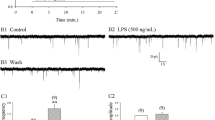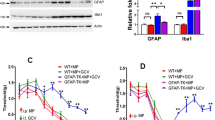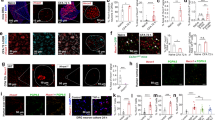Abstract
A major unresolved issue in treating pain is the paradoxical hyperalgesia produced by the gold-standard analgesic morphine and other opiates. We found that hyperalgesia-inducing treatment with morphine resulted in downregulation of the K+-Cl− co-transporter KCC2, impairing Cl− homeostasis in rat spinal lamina l neurons. Restoring the anion equilibrium potential reversed the morphine-induced hyperalgesia without affecting tolerance. The hyperalgesia was also reversed by ablating spinal microglia. Morphine hyperalgesia, but not tolerance, required μ opioid receptor–dependent expression of P2X4 receptors (P2X4Rs) in microglia and μ-independent gating of the release of brain-derived neurotrophic factor (BDNF) by P2X4Rs. Blocking BDNF-TrkB signaling preserved Cl− homeostasis and reversed the hyperalgesia. Gene-targeted mice in which Bdnf was deleted from microglia did not develop hyperalgesia to morphine. However, neither morphine antinociception nor tolerance was affected in these mice. Our findings dissociate morphine-induced hyperalgesia from tolerance and suggest the microglia-to-neuron P2X4-BDNF-KCC2 pathway as a therapeutic target for preventing hyperalgesia without affecting morphine analgesia.
This is a preview of subscription content, access via your institution
Access options
Subscribe to this journal
Receive 12 print issues and online access
$209.00 per year
only $17.42 per issue
Buy this article
- Purchase on Springer Link
- Instant access to full article PDF
Prices may be subject to local taxes which are calculated during checkout








Similar content being viewed by others
References
Bekhit, M.H. Opioid-induced hyperalgesia and tolerance. Am. J. Ther. 17, 498–510 (2010).
Lee, M., Silverman, S.M., Hansen, H., Patel, V.B. & Manchikanti, L. A comprehensive review of opioid-induced hyperalgesia. Pain Physician 14, 145–161 (2011).
Mao, J., Sung, B., Ji, R.R. & Lim, G. Chronic morphine induces downregulation of spinal glutamate transporters: implications in morphine tolerance and abnormal pain sensitivity. J. Neurosci. 22, 8312–8323 (2002).
Vanderah, T.W. et al. Tonic descending facilitation from the rostral ventromedial medulla mediates opioid-induced abnormal pain and antinociceptive tolerance. J. Neurosci. 21, 279–286 (2001).
Heinke, B., Gingl, E. & Sandkuhler, J. Multiple targets of mu-opioid receptor–mediated presynaptic inhibition at primary afferent Adelta- and C-fibers. J. Neurosci. 31, 1313–1322 (2011).
Zeng, J., Thomson, L.M., Aicher, S.A. & Terman, G.W. Primary afferent NMDA receptors increase dorsal horn excitation and mediate opiate tolerance in neonatal rats. J. Neurosci. 26, 12033–12042 (2006).
Woolf, C.J. & Salter, M.W. Neuronal plasticity: increasing the gain in pain. Science 288, 1765–1769 (2000).
Craig, A.D. Pain mechanisms: labeled lines versus convergence in central processing. Annu. Rev. Neurosci. 26, 1–30 (2003).
Drdla, R., Gassner, M., Gingl, E. & Sandkuhler, J. Induction of synaptic long-term potentiation after opioid withdrawal. Science 325, 207–210 (2009).
Sandkühler, J. Models and mechanisms of hyperalgesia and allodynia. Physiol. Rev. 89, 707–758 (2009).
Zeilhofer, H.U., Benke, D. & Yevenes, G.E. Chronic pain states: pharmacological strategies to restore diminished inhibitory spinal pain control. Annu. Rev. Pharmacol. Toxicol. 52, 111–133 (2012).
Coull, J.A. et al. Trans-synaptic shift in anion gradient in spinal lamina I neurons as a mechanism of neuropathic pain. Nature 424, 938–942 (2003).
Keller, A.F., Beggs, S., Salter, M.W. & De Koninck, Y. Transformation of the output of spinal lamina I neurons after nerve injury and microglia stimulation underlying neuropathic pain. Mol. Pain 3, 27 (2007).
Cordero-Erausquin, M., Coull, J.A., Boudreau, D., Rolland, M. & De Koninck, Y. Differential maturation of GABA action and anion reversal potential in spinal lamina I neurons: impact of chloride extrusion capacity. J. Neurosci. 25, 9613–9623 (2005).
Sjøgren, P., Jonsson, T., Jensen, N.H., Drenck, N.E. & Jensen, T.S. Hyperalgesia and myoclonus in terminal cancer patients treated with continuous intravenous morphine. Pain 55, 93–97 (1993).
Hewitt, S.A., Wamsteeker, J.I., Kurz, E.U. & Bains, J.S. Altered chloride homeostasis removes synaptic inhibitory constraint of the stress axis. Nat. Neurosci. 12, 438–443 (2009).
Kemp, T., Spike, R.C., Watt, C. & Todd, A.J. The mu-opioid receptor (MOR1) is mainly restricted to neurons that do not contain GABA or glycine in the superficial dorsal horn of the rat spinal cord. Neuroscience 75, 1231–1238 (1996).
Smirnov, S., Paalasmaa, P., Uusisaari, M., Voipio, J. & Kaila, K. Pharmacological isolation of the synaptic and nonsynaptic components of the GABA-mediated biphasic response in rat CA1 hippocampal pyramidal cells. J. Neurosci. 19, 9252–9260 (1999).
Doyon, N. et al. Efficacy of synaptic inhibition depends on multiple, dynamically interacting mechanisms implicated in chloride homeostasis. PLoS Comput. Biol. 7, e1002149 (2011).
Staley, K.J., Soldo, B.L. & Proctor, W.R. Ionic mechanisms of neuronal excitation by inhibitory GABAA receptors. Science 269, 977–981 (1995).
Prescott, S.A., Sejnowski, T.J. & De Koninck, Y. Reduction of anion reversal potential subverts the inhibitory control of firing rate in spinal lamina I neurons: towards a biophysical basis for neuropathic pain. Mol. Pain 2, 32 (2006).
Coull, J.A. et al. BDNF from microglia causes the shift in neuronal anion gradient underlying neuropathic pain. Nature 438, 1017–1021 (2005).
Blaesse, P. et al. Oligomerization of KCC2 correlates with development of inhibitory neurotransmission. J. Neurosci. 26, 10407–10419 (2006).
Chorin, E. et al. Upregulation of KCC2 activity by zinc-mediated neurotransmission via the mZnR/GPR39 receptor. J. Neurosci. 31, 12916–12926 (2011).
Beggs, S. & Salter, M.W. Microglia-neuronal signalling in neuropathic pain hypersensitivity 2.0. Curr. Opin. Neurobiol. 20, 474–480 (2010).
Zhao, P., Waxman, S.G. & Hains, B.C. Extracellular signal–regulated kinase-regulated microglia-neuron signaling by prostaglandin E2 contributes to pain after spinal cord injury. J. Neurosci. 27, 2357–2368 (2007).
Tsuda, M. et al. P2X4 receptors induced in spinal microglia gate tactile allodynia after nerve injury. Nature 424, 778–783 (2003).
Tsuda, M., Tozaki-Saitoh, H. & Inoue, K. Pain and purinergic signaling. Brain Res. Rev. 63, 222–232 (2010).
Trang, T., Beggs, S., Wan, X. & Salter, M.W. P2X4 receptor–mediated synthesis and release of brain-derived neurotrophic factor in microglia is dependent on calcium and p38 mitogen–activated protein kinase activation. J. Neurosci. 29, 3518–3528 (2009).
Ulmann, L. et al. Upregulation of P2X4 receptors in spinal microglia after peripheral nerve injury mediates BDNF release and neuropathic pain. J. Neurosci. 28, 11263–11268 (2008).
De Koninck, Y. Altered chloride homeostasis in neurological disorders: a new target. Curr. Opin. Pharmacol. 7, 93–99 (2007).
Mannion, R.J. et al. Neurotrophins: peripherally and centrally acting modulators of tactile stimulus-induced inflammatory pain hypersensitivity. Proc. Natl. Acad. Sci. USA 96, 9385–9390 (1999).
Boillée, S. et al. Onset and progression in inherited ALS determined by motor neurons and microglia. Science 312, 1389–1392 (2006).
Rios, M. et al. Conditional deletion of brain-derived neurotrophic factor in the postnatal brain leads to obesity and hyperactivity. Mol. Endocrinol. 15, 1748–1757 (2001).
Matthes, H.W. et al. Loss of morphine-induced analgesia, reward effect and withdrawal symptoms in mice lacking the mu-opioid-receptor gene. Nature 383, 819–823 (1996).
Horvath, R.J., Romero-Sandoval, E.A. & De Leo, J.A. Inhibition of microglial P2X4 receptors attenuates morphine tolerance, Iba1, GFAP and mu opioid receptor protein expression while enhancing perivascular microglial ED2. Pain 150, 401–413 (2010).
Hutchinson, M.R. et al. Exploring the neuroimmunopharmacology of opioids: an integrative review of mechanisms of central immune signaling and their implications for opioid analgesia. Pharmacol. Rev. 63, 772–810 (2011).
Xu, J., Xu, M., Rossi, G.C., Pasternak, G.W. & Pan, Y.X. Identification and characterization of seven new exon 11–associated splice variants of the rat mu opioid receptor gene, OPRM1. Mol. Pain 7, 9 (2011).
Wang, X. et al. Morphine activates neuroinflammation in a manner parallel to endotoxin. Proc. Natl. Acad. Sci. USA 109, 6325–6330 (2012).
Bohn, L.M., Gainetdinov, R.R., Lin, F.T., Lefkowitz, R.J. & Caron, M.G. Mu-opioid receptor desensitization by beta-arrestin-2 determines morphine tolerance, but not dependence. Nature 408, 720–723 (2000).
Mao, J. Opioid-induced abnormal pain sensitivity: implications in clinical opioid therapy. Pain 100, 213–217 (2002).
Wang, Y. et al. Blockade of PDGFR-beta activation eliminates morphine analgesic tolerance. Nat. Med. 18, 385–387 (2012).
Knabl, J. et al. Reversal of pathological pain through specific spinal GABAA receptor subtypes. Nature 451, 330–334 (2008).
Asiedu, M., Ossipov, M.H., Kaila, K. & Price, T.J. Acetazolamide and midazolam act synergistically to inhibit neuropathic pain. Pain 148, 302–308 (2010).
Horvath, R.J. & DeLeo, J.A. Morphine enhances microglial migration through modulation of P2X4 receptor signaling. J. Neurosci. 29, 998–1005 (2009).
Takayama, N. & Ueda, H. Morphine-induced chemotaxis and brain-derived neurotrophic factor expression in microglia. J. Neurosci. 25, 430–435 (2005).
Merighi, A. et al. BDNF as a pain modulator. Prog. Neurobiol. 85, 297–317 (2008).
Zhao, J. et al. Nociceptor-derived brain-derived neurotrophic factor regulates acute and inflammatory, but not neuropathic pain. Mol. Cell. Neurosci. 31, 539–548 (2006).
Boulenguez, P. et al. Down-regulation of the potassium-chloride cotransporter KCC2 contributes to spasticity after spinal cord injury. Nat. Med. 16, 302–307 (2010).
Vargas-Perez, H. et al. Ventral tegmental area BDNF induces an opiate-dependent-like reward state in naive rats. Science 324, 1732–1734 (2009).
Sim, J.A. et al. Altered hippocampal synaptic potentiation in P2X4 knock-out mice. J. Neurosci. 26, 9006–9009 (2006).
Poltorak, A. et al. Defective LPS signaling in C3H/HeJ and C57BL/10ScCr mice: mutations in Tlr4 gene. Science 282, 2085–2088 (1998).
Wang, Y. et al. Age-dependent morphine tolerance development in the rat. Anesth. Analg. 100, 1733–1739 (2005).
Trang, T., Ma, W., Chabot, J.G., Quirion, R. & Jhamandas, K. Spinal modulation of calcitonin gene–related peptide by endocannabinoids in the development of opioid physical dependence. Pain 126, 256–271 (2006).
Yaksh, T.L., Jessell, T.M., Gamse, R., Mudge, A.W. & Leeman, S.E. Intrathecal morphine inhibits substance P release from mammalian spinal cord in vivo. Nature 286, 155–157 (1980).
Salter, M.W. & Hicks, J.L. ATP causes release of intracellular Ca2+ via the phospholipase C beta/IP3 pathway in astrocytes from the dorsal spinal cord. J. Neurosci. 15, 2961–2971 (1995).
De la Calle, J.L. & Paino, C.L. A procedure for direct lumbar puncture in rats. Brain Res. Bull. 59, 245–250 (2002).
Lorenzo, L.E., Ramien, M., St Louis, M., De Koninck, Y. & Ribeiro-da-Silva, A. Postnatal changes in the Rexed lamination and markers of nociceptive afferents in the superficial dorsal horn of the rat. J. Comp. Neurol. 508, 592–604 (2008).
Acknowledgements
We thank K. Bachand for technical assistance with behavior, F. Rassendren (INSERM) for P2rx4−/− mice, C.J. Evans (National Institute on Drug Abuse) for (+)naloxone and J. Vlahakis for (+)naloxone polarimetric analysis. This paper is dedicated to the memory of Karen Vandal, who passed away during the course of this study. This work was supported by Canadian Institutes for Health Research (CIHR) grants to Y.D.K., M.W.S., C.M.C. and J.-M.B., by the Krembil Foundation (Y.D.K. and M.W.S.), the Regione Piemonte/University of Turin Fellowship Program (F.F.), the CIHR Fellowship program (T.T. and L.-E.L.), the Howard Hughes Medical Institute (M.W.S.), the Anne and Max Tanenbaum Chair Program (M.W.S.), the Canada Research Chairs Program (C.M.C., J.-M.B. and M.W.S.), the Fonds de la recherche en santé du Québec Chercheur National Program (Y.D.K.) and the Ontario Research Fund Research Excellence Program (M.W.S.).
Author information
Authors and Affiliations
Contributions
F.F., T.T., C.M.C., M.W.S. and Y.D.K. conceived and designed the project. C.M.C., J.-M.B., Y.D.K. and M.W.S. supervised the experiments. F.F., T.T., T.-A.M.M., S.L., T.D., L.-E.L., A.C., W.Z., D.M., S.B. and K.V. performed the experiments. N.D. performed computer simulations and contributed to interpretation of results. S.B. generated CD11b-cre; BdnfloxP/loxP mice. F.F., T.T., T.-A.M.M., S.L., T.D., L.-E.L., A.C., N.D., W.Z. and A.G.G. analyzed the data. F.F., T.T., M.W.S. and Y.D.K. wrote the manuscript. All of the authors read and discussed the manuscript.
Corresponding author
Ethics declarations
Competing interests
The authors declare no competing financial interests.
Supplementary information
Supplementary Text and Figures
Supplementary Figures 1–4 (PDF 1719 kb)
Rights and permissions
About this article
Cite this article
Ferrini, F., Trang, T., Mattioli, TA. et al. Morphine hyperalgesia gated through microglia-mediated disruption of neuronal Cl− homeostasis. Nat Neurosci 16, 183–192 (2013). https://doi.org/10.1038/nn.3295
Received:
Accepted:
Published:
Issue Date:
DOI: https://doi.org/10.1038/nn.3295
This article is cited by
-
Pathogenic mechanisms of human immunodeficiency virus (HIV)-associated pain
Molecular Psychiatry (2023)
-
Development of opioid-induced hyperalgesia depends on reactive astrocytes controlled by Wnt5a signaling
Molecular Psychiatry (2023)
-
Emergence of consciousness from anesthesia through ubiquitin degradation of KCC2 in the ventral posteromedial nucleus of the thalamus
Nature Neuroscience (2023)
-
Effects of Different Doses of Esketamine on Pain Sensitivity of Patients Undergoing Thyroidectomy: A Randomized Controlled Trial
Pain and Therapy (2023)
-
Targeting Peripheral μ-opioid Receptors or μ-opioid Receptor-Expressing Neurons Does not Prevent Morphine-induced Mechanical Allodynia and Anti-allodynic Tolerance
Neuroscience Bulletin (2023)



